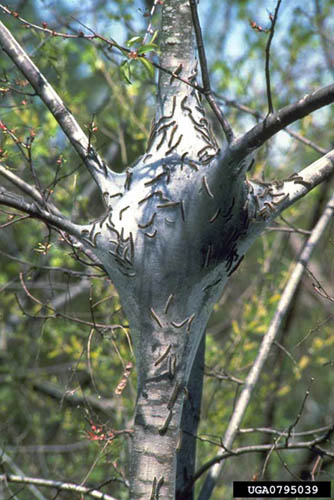Eastern tent caterpillar
Malacosoma americanum
Natural History

Tent made by eastern tent caterpillar
Photo credit: William H. Hoffard - USDA Forest Service
The eastern tent caterpillar (Malacosoma americanum) is found throughout the United States, including Florida. The caterpillar feeds on many hardwood species. Its damage does not kill trees but some twig, branch, or leaf loss is likely. The caterpillar builds a tent-like structure in the forks of tree branches. Many people find these structures unattractive.
In February or March, the larvae emerge from their egg mass and immediately build their silken tents among the branches and leaves of trees. These caterpillars come out of their tents each day to feed on nearby leaves and they eat the entire leaves except the midrib.
For about six weeks, the larvae grow and expand their tents as they grow and feed. On small trees with many tents, the entire tree can become covered with webbing as the young larvae continually enlarge their tents to reach more leaves.
Eventually, the larvae build a cocoon, usually inside the tent. Two weeks later, the adult moths emerge and mate. Females lay eggs on the branches of a host tree and the cycle starts again. The egg masses are particularly distinctive; they encircle a twig such as a bun would surround a hot dog. The egg masses can contain hundreds of eggs. These eggs usually appear shiny, as if their surfaces are varnished.
